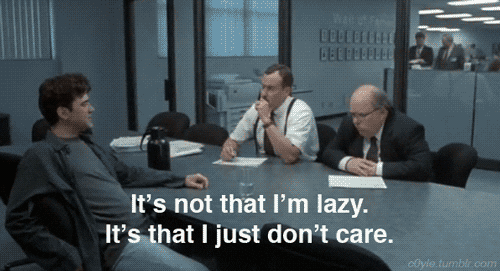Anyone who has ever worked in an office setting can likely relate to the 1999 movie called “Office Space”. The main character, Peter, is utterly worn out and demoralized because he has based his whole work existence on doing and saying the “right” things, even though he is working in a very dysfunctional environment. All the while, he is losing his own self-respect and becoming increasingly unproductive and bitter.
One day, he decides to seek help through hypnosis, but when the hypnotist suddenly dies in the middle of their session, he finds himself stuck in a hypnotic state of believing that nothing matters. This sets him off in a new direction of saying and doing anything he feels, without caring about repercussions. This movie perfectly illustrates the dangerous paradigm of either becoming so compliant in a broken system that you end up with no voice at all, or else checking out mentally and not caring about whether it succeeds or fails.

It’s an all too common situation, which is why the movie resonated with so many people. And it is a critical point in The Relevance Path, because within this model, the reasonable middle ground of relevance can provide a solution.
In one of the scenes, Peter tries to visualize what he wants his life to be like and discusses his dreams with his neighbor, a construction worker. His neighbor asks him what he would do if he had a million dollars, and Peter says, “I’d do nothing. I would sit around and relax all day. I would do nothing.” The neighbor then replies, “You don’t need a million dollars to do nothing, man. Take a look at my cousin. He’s broke and he don’t do s#*%.”
Although crude, the conversation serves as a rudimentary example of an enhancement dialogue. It’s a conversation in which someone asks and answers questions to help a person understand their apparent and latent goals, as well as their obstacles. Peter is deeply unhappy at work and thinks that if he had a million dollars, he’d be able to sit around and relax. If his friend had been a Pathorian, he might have pointed out that if Peter persisted in thinking that a million dollars was what he needed for his goal, he’d likely find out that getting that much money requires a lot of work, which is the opposite of what Peter desires. Ironically, he might have to spend the next few years working even harder, possibly inventing something or opening a business, navigating all of the associated obstacles, all to get to his goal of doing nothing. Talk about requirements creep! Suddenly he’d be required to get up early, learn new skills, or many other things needed to get to the million dollar apparent goal. His friend correctly pointed out that if doing nothing was his real, latent goal, he didn’t need a million dollars to do it.
The visualization and enhancement steps are so critically important because having already reviewed and assessed what the problems are, it’s time to put the focus on a solution. Taking time to imagine what a real solution looks like, including using some critical questioning to discover what the actual goal is, and what it takes to get there, will save tremendous time and effort.
About the Author:
Jane B is an analyst, linguist, and trainer for Pathoras. She is a ‘Jane of All Trades’ ensuring her customer’s success.


Trackbacks/Pingbacks